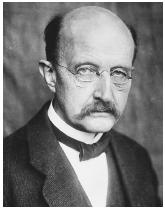Max Planck

GERMAN PHYSICIST
1858–1947
Max Karl Ernst Ludwig Planck was born into a family of lawyers and clergymen, and he became the fourth generation of university professors from his family. As a child, he exhibited considerable talent in mathematics, music, and philology (the scientific study of language). By 1874, when he entered the University of Munich, the sixteen-year-old Planck had decided to study mathematics. Very quickly, however, he became interested in physics and the application of mathematics to the physical world. The university's professor of physics, Philip von Jolly, discouraged the young student from studying physics because—as Jolly told him—it was very nearly a closed subject with little left to discover. Luckily, Planck disregarded his professor's advice.
Planck also studied at the University of Berlin with such notable physicists as Gustav Kirchhoff, whom he thought brilliant, but a dry and boring teacher. He also became familiar with the thermodynamics research of Rudolf Clausius, and in 1879 Planck received his Ph.D. from the University of Munich, only three months after his twenty-first birthday. His dissertation explored the second law of thermodynamics.
After holding posts at the universities of Munich and Kiel, Planck succeeded Kirchhoff at the University of Berlin in 1888 after the latter's death. Planck continued his research in thermodynamics, including attempts to connect heat with the Scottish physicist James Clerk Maxwell's theory of electromagnetic radiation. He also addressed a problem suggested by Kirch-hoff, who had earlier established that the energy of radiation emitted by a blackbody depends on temperature and the frequency of the radiation.
A blackbody is any object that absorbs all the radiation falling on its surface. Thus, it appears black. A perfect absorber, a blackbody is also a perfect emitter of radiation, and Kirchhoff had challenged physicists to find the mathematical equation relating the energy to temperature and frequency.
The German physicist Wilhelm Wien had proposed such an equation, which worked well only for high frequencies, and Lord Rayleigh (born John William Strutt) proposed another equation, which worked well only at low frequencies. In 1900 Planck was able to develop a single expression that combined these two earlier equations and accurately predicted the energy over the entire range of frequencies.
Subsequently, Planck tried to provide a theoretical basis for his equation. He found that to do so, it was necessary to reject the idea from classical physics that electromagnetic radiation is wavelike and continuous and instead to make the bold assumption that it is particle-like and discrete. Planck assumed that radiation can occur in discrete packets of energy, which Albert Einstein called "quanta." This radical idea is expressed in the equation
E = hν
in which the energy E is directly proportional to the frequency v, and the proportionality constant h, now known as Planck's constant, has the value 6.62 × 10 −34 joule per second.
Planck's revolutionary idea about energy provided the basis for Einstein's explanation of the photoelectric effect in 1906 and for the Danish physicist Niels Bohr's atomic model of the hydrogen atom in 1913. Their success, in turn, lent support to Planck's theories, for which he received the Nobel Prize in physics in 1918. In the mid-1920s the combination of Planck's ideas about the particle-like nature of electromagnetic radiation and French physicist Louis de Broglie's hypothesis of the wavelike nature of electrons led to the formulation of quantum mechanics, which is still the accepted theory for the behavior of matter at atomic and subatomic levels.
By the second decade of the twentieth century, Planck was less active in quantum theory research, taking on, in addition to his teaching responsibilities, various administrative duties, including the presidency of the Kaiser Wilhelm Gesellschaft during the years 1930 through 1937 and again after World War II from 1945 until 1946. Planck suffered many personal losses during this part of his life. His first wife died in 1909; his elder son was killed in World War I; and his two daughters both died in childbirth during the early part of the century. In World War II his younger son was executed after being accused of helping plot the assassination of Adolf Hitler, and his home and library were destroyed by Allied bombing. Planck spent the last few years of his life in Göttingen, living long enough to witness the establishment of the Max Planck Gessellschaft from the earlier Kaiser Wilhelm Gesellschaft, to which he had devoted so much of his professional life.
SEE ALSO Bohr, Niels ; De Broglie, Louis ; Einstein, Albert ; Maxwell, James Clerk .
Richard E. Rice
Bibliography
Heathcote, Niels H. de V. (1971). Nobel Prize Winners in Physics, 1901–1950. Freeport, NY: Books for Libraries Press.
Heilbron, J. L. (1986). The Dilemmas of an Upright Man: Max Planck as Spokesman for German Science. Berkeley: University of California Press.
Planck, Max (1949). Autobiography and Other Papers. New York: Philosophical Library.
Weber, Robert L. (1988). Pioneers of Science: Nobel Prize Winners in Physics, 2nd edition Bristol, U.K.: Adam Hilger.
Comment about this article, ask questions, or add new information about this topic: